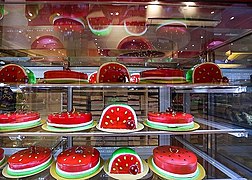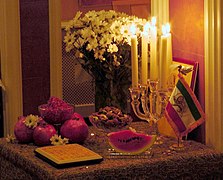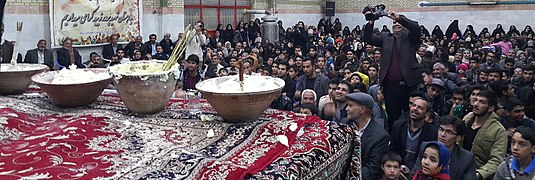Yaldā Night
| Yaldā Night | |
|---|---|
 | |
| Observed by | Iran Azerbaijan Afghanistan Iraqi Kurdistan Tajikistan Turkey (by Kurds and Azeris) |
| Significance | Longest night of the year[rs 1] |
| Date | December 20, 21 or 22 (night of the Winter Solstice) |
| 2020 date | 20 December[1] |
| Frequency | annual |
| Related to | Nowruz, Tirgan, Chaharshanbe Suri |
| History of Iran |
|---|
 |
|
Timeline |
Yaldā Night (Persian: شب یلدا shab-e yalda) or Chelleh Night (Persian: شب چله shab-e chelle) is an Iranian[2][3] Northern Hemisphere's winter solstice festival celebrated on the "longest and darkest night of the year."[rs 1] According to the calendar, this corresponds to the night of December 20/21 (±1) in the Gregorian calendar, and to the night between the last day of the ninth month (Azar) and the first day of the tenth month (Dey)[rs 2] of the Iranian solar calendar.[rs 2]
The longest and darkest night of the year is a time when friends and family gather together to eat, drink and read poetry (especially Hafez) and Shahnameh until well after midnight. Fruits and nuts are eaten and pomegranates and watermelons are particularly significant. The red color in these fruits symbolizes the crimson hues of dawn and glow of life. The poems of Divan-e Hafez, which can be found in the bookcases of most Iranian families, are read or recited on various occasions such as this festival and Nowruz. Shab-e Yalda was officially added to Iran's List of National Treasures in a special ceremony in 2008.[citation needed]
Names[]
The longest and darkest night of the year marks "the night opening the initial forty-day period of the three-month winter",[rs 1] from which the name Chelleh, "fortieth", derives.[rs 2] There are all together three 40-day periods, one in summer, and two in winter. The two winter periods are known as the "great Chelleh" period (1 Day to 11 Bahman,[rs 2] 40 full days), followed/overlapped by the "small Chelleh" period (10 Bahman to 30 Bahman,[rs 2] 20 days + 20 nights = 40 nights and days). Shab-e Chelleh is the night opening the "big Chelleh" period, that is the night between the last day of autumn and the first day of winter. The other name of the festival, 'Yaldā', is ultimately a borrowing from Syriac-speaking Christians.[rs 1][rs 3][rs 4][rs 5] In the 1st century, significant numbers of Eastern Christians were settled in Parthian and Sasanian territories, where they had received protection from religious persecution.[4] Through them, Iranians (i.e. Parthians, Persians etc.) came in contact with Christian religious observances, including, it seems, Nestorian Christian Yalda, which in Syriac (a Middle Aramaic dialect) literally means "birth" but in a religious context was also the Syriac Christian proper name for Christmas,[rs 6][rs 4][rs 1][rs 3] and which—because it fell nine months after Annunciation—was celebrated on eve of the winter solstice. The Christian festival's name passed to the non-Christian neighbors[rs 4][rs 1][rs 3][rs 5] and although it is not clear when and where the Syriac term was borrowed into Persian, gradually 'Shab-e Yalda' and 'Shab-e Chelleh' became synonymous and the two are used interchangeably.[citation needed]
Customs and traditions[]

In Zoroastrian tradition the longest and darkest night of the year was a particularly inauspicious day, and the practices of what is now known as "Shab-e Chelleh/Yalda" were originally customs intended to protect people from evil (see dews) during that long night,[rs 7] at which time the evil forces of Ahriman were imagined to be at their peak. People were advised to stay awake most of the night, lest misfortune should befall them, and people would then gather in the safety of groups of friends and relatives, share the last remaining fruits from the summer, and find ways to pass the long night together in good company.[rs 7] The next day (i.e. the first day of Dae month) was then a day of celebration,[note 1] and (at least in the 10th century, as recorded by Al-Biruni), the festival of the first day of Dae month was known as Ḵorram-ruz (joyful day) or Navad-ruz (ninety days [left to Nowruz]).[rs 1] Although the religious significance of the long dark night has been lost, the old traditions of staying up late in the company of friends and family have been retained in Iranian culture to the present day.[citation needed]
References to other older festivals held around the winter solstice are known from both Middle Persian texts as well as texts of the early Islamic period.[rs 1] In the 10th century, Al-Biruni mentions the mid-year festival (Maidyarem Gahanbar) that ran from 11-15 Dae. This festival is generally assumed to have been originally on the winter solstice,[rs 8][rs 9] and which gradually shifted through the introduction of incalcation.cf. [rs 9] Al-Biruni also records an Adar Jashan festival of fire celebrated on the intersection of Adar day (9th) of Adar month (9th), which is the last autumn month.[rs 1] This was probably the same as the fire festival called Shahrevaragan (Shahrivar day of Shahrivar month), which marked the beginning of winter in Tokarestan.[rs 1] In 1979, journalist Hashem Razi theorized that Mehregan — the day-name festival of Mithra that in pre-Islamic times was celebrated on the autumn equinox and is today still celebrated in the autumn — had in early Islamic times shifted to the winter solstice.[rs 10] Razi based his hypothesis on the fact that some of the poetry of the early Islamic era refers to Mihragan in connection with snow and cold. Razi's theory has a significant following on the Internet, but while Razi's documentation has been academically accepted, his adduction has not.[rs 4] Sufism's Chella, which is a 40-day period of retreat and fasting,[rs 11] is also unrelated to winter solstice festival.[citation needed]
Food plays a central role in the present-day form of the celebrations. In most parts of Iran the extended family come together and enjoy a fine dinner. A wide variety of fruits and sweetmeats specifically prepared or kept for this night are served. Foods common to the celebration include watermelon, pomegranate, nuts, and dried fruit.[5] These items and more are commonly placed on a korsi, which people sit around. In some areas it is custom that forty varieties of edibles should be served during the ceremony of the night of Chelleh.[citation needed]
Light-hearted superstitions run high on the night of Chelleh. These superstitions, however, are primarily associated with consumption. For instance, it is believed that consuming watermelons on the night of Chelleh will ensure the health and well-being of the individual during the months of summer by protecting him from falling victim to excessive heat or disease produced by hot humors. In Khorasan, there is a belief that whoever eats carrots, pears, pomegranates, and green olives will be protected against the harmful bite of insects, especially scorpions. Eating garlic on this night protects one against pains in the joints.[rs 2]
After dinner the older individuals entertain the others by telling them tales and anecdotes. Another favorite and prevalent pastime of the night of Chelleh is fāl-e Ḥāfeẓ, which is divination using the Dīvān of Hafez (i.e. bibliomancy). It is believed that one should not divine by the Dīvān of Hafez more than three times, however, or the poet may get angry.[rs 2]
Activities common to the festival include staying up past midnight, conversation, drinking, reading poems out loud, telling stories and jokes, and for some dancing. Prior to invention and prevalence of electricity, decorating and lighting the house and yard with candles was also part of the tradition, but few have continued this tradition. Another tradition is giving dried fruits and nuts to family and friends, wrapped in tulle and tied with ribbon (similar to wedding and shower "party favors"). Prior to ban of alcohol, drinking wine was also part of the celebration. Despite the Islamic alcohol ban in Iran, many continue to include home-made alcoholic drinks in their celebrations.[citation needed]
In film[]
The storyline of the 2019 Iranian film Yalda, a Night for Forgiveness is based on an actual top-rating Iranian reality television show which was actually aired during Ramadan, but which in the film, under dramatic licence, is aired on Yalda night. In the film, a young woman convicted of murder pleads for the daughter of the victim to grant her forgiveness and save her from the death penalty.[6][7]
Gallery[]

Yaldā Night shopping in Gorgan

2017 Yaldā Night at Sarpol-e Zahab

2019 Yaldā Night in Iran

Yaldā Night cakes in Isfahan

Fruits and Divan of Hafez on Yaldā Night

Yalda night table, Amsterdam

Special ceremony on Yalda night zibad

Yalda sweets

Yalda ceremony

Traditional sweet of Yaldā in Zibad, Razavi Khorasan Province

An Iranian girl sitting at the Yalda table.

Cooked beets

During the Yalda night one of the main fruits eaten is pomegranates.

Various nuts, such as walnuts and pistachios, are eaten on Yalda Night.

The book of Ghazals of Hafiz
Footnotes[]
- ^ The first day (Ormuzd day) of Dae month was/is the first of the four name-day feast days of the Creator Ahura Mazda (Dae, "Creator"; Ormuzd = Ahura Mazda),[rs 8] for which Al-Biruni notes that in earlier times, "on the day and month both called by the name of God, i.e. (Hormuzd), [...] the king used to descend from the throne of the empire in white dresses, [...] suspend all the pomp of royalty, and exclusively give himself up to considerations of the affairs of the realm and its inhabitants." Anyone could address the king, and the monarch would meet with commoners, eat and drink with them, and he would declare his brothership with them, and acknowledge his dependency on them (Albîrûnî, "Dai-Mâh", On the Festivals in the Months of the Persians in The Chronology of Ancient Nations, tr. Sachau, pp. 211–212).
References[]
Group 1[]
- ^ Jump up to: a b c d e f g h i j Krasnowolska, Anna (2009), "Sada Festival", Encyclopaedia Iranica, New York: iranicaonline.com.
- ^ Jump up to: a b c d e f g Omidsalar, Mahmoud (1990), "Čella I: In Persian Folklore", Encyclopaedia Iranica, vol. V, New York: Routledge & Kegan Paul, pp. 123–124.
- ^ Jump up to: a b c Āryān, Qamar (1991), "Christianity VI: In Persian Literature.", Encyclopedia Iranica, vol. V, f5, Costa Mesa: Mazda Publishers, pp. 539–542.
- ^ Jump up to: a b c d Krasnowolska, Anna (1999), "Šab-e Čella", Folia Orientalia, 35: 55–74.
- ^ Jump up to: a b Dehkhoda, Ali Akbar; et al., eds. (1995), "یلدا", Loghat Nāmeh Dehkhodā: The Encyclopaedic Dictionary of the Persian Language, Costa Mesa: Mazda Publishers.
- ^ Payne Smith, J., ed. (1903), "ܝܠܕܐ", Syriac Dictionary, Oxford: Clarendon, p. 192.
- ^ Jump up to: a b Daniel, Elton L.; Mahdi, Ali Akbar (2006), Culture and customs of Iran, Westport: Greenwood, p. 188, ISBN 0-313-32053-5.
- ^ Jump up to: a b Boyce, Mary (1999), "Festivals I", Encyclopedia Iranica, vol. IX, f5, Costa Mesa: Mazda, pp. 543–546.
- ^ Jump up to: a b Boyce, Mary (1983), "Iranian Festivals", Cambridge History of Iran, vol. 3(2), Cambridge University Press, pp. 792–818.
- ^ Razi, Hashem (1979), Gahshomari wa jashnha-e iran-e bastan, (Time-calculation and Festivals of ancient Iran), Tehran, pp. 565–631, repr. 2001.
- ^ Algar, Hamid (1990), "Čella II: In Sufism", Encyclopaedia Iranica, vol. V, New York: Routledge & Kegan Paul, pp. 124–125.
Group 2[]
- ^ "Celebrities urge fans to celebrate Yalda with no gatherings in COVID-19 era". Tehran Times. 18 December 2020. Retrieved 19 December 2020.
- ^ "ČELLA – Encyclopaedia Iranica". www.iranicaonline.org.
- ^ Richter, Joanne (2005). Iran, the culture. New York: Crabtree Pub. Co. pp. 18. ISBN 0-7787-9317-6.
- ^ von Harnack, Adolph (1905). The Expansion of Christianity in the First Three Centuries. Williams & Norgate. p. 293.
- ^ Bahrami, Askar, Jashnha-ye Iranian, Tehran, 1383, pp. 75–76.
- ^ Hadadi, Roxana (7 March 2020). "Performing Reality in the Iranian Courtroom-Style Drama Yalda, a Night for Forgiveness – Chaz's Journal". Roger Ebert. Retrieved 25 October 2020.
- ^ "Yalda, A Night for Forgiveness". Adelaide Film Festival. 23 October 2020. Retrieved 25 October 2020.
External links[]
- Čella at Encyclopædia Iranica
 Media related to Yalda night at Wikimedia Commons
Media related to Yalda night at Wikimedia Commons
- Festivals in Iran
- December observances
- Persian culture
- Observances set by the Solar Hijri calendar
- Winter events in Iran














